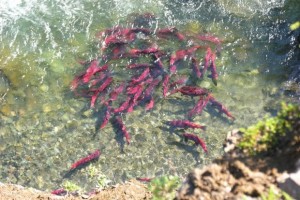15
Apr
Fish from Alaskan Wilderness Contaminated with Banned Pesticides
(Beyond Pesticides, April 15, 2014) A new study released last week by the National Park Service on contaminant use in Alaska, found traces of pesticides in fish ””pesticides which have long been banned and likely never been used within the Alaskan wilderness areas. Researchers examined three Alaskan parks renowned for their remote, pristine and protected wilderness ””Lake Clark National Park, Wrangell-St. Elias National Park and Katmai National Park”” only to find that contaminants, including PCBs at concentrations exceeding those in the lower 48 states.
 The study, Contaminants of Emerging Concern in Fish from Western US and Alaska National Parks””Spatial Distribution and Health Thresholds, published in the Journal of the American Water Resources Association, sought to compare contaminant level found within fish across the nation. Generally, researchers found that Alaskan fish were more likely to have traces of older chemicals, while those in the lower 48 tended to be dominated by newer chemicals. The most commonly detected chemicals are PCBs, endosulfan, sulfate and p,p’-DDE, a breakdown product of DDT. Some of these long-banned chemicals actually exceed the U.S. Environmental Protection Agency’s (EPA) guidelines for human subsistence on fish and wildlife.
The study, Contaminants of Emerging Concern in Fish from Western US and Alaska National Parks””Spatial Distribution and Health Thresholds, published in the Journal of the American Water Resources Association, sought to compare contaminant level found within fish across the nation. Generally, researchers found that Alaskan fish were more likely to have traces of older chemicals, while those in the lower 48 tended to be dominated by newer chemicals. The most commonly detected chemicals are PCBs, endosulfan, sulfate and p,p’-DDE, a breakdown product of DDT. Some of these long-banned chemicals actually exceed the U.S. Environmental Protection Agency’s (EPA) guidelines for human subsistence on fish and wildlife.
Among those exceeding acceptable levels, dieldrin, chlordane, and p,p’-DDE have been identified as persistent organic pollutants (POPs) by EPA and by the parties of the Stockholm Convention, an international treaty established in 2001 to eliminate or reduce the release of POPs into the environment. Although the treaty was signed in 2001 by the U.S., it has yet to be ratified by the U.S. Senate
The cause for the surge in older chemical contaminant concentrations, researchers suspect, is that fish in Alaska tend to be much larger in Alaska than elsewhere. “The bigger fish accumulate more contaminants because they are older,” explained co-author Colleen Flanagan Pritz, ecologist with the National Park Service’s Air Resources Division.
Transport of contaminant to northerly environmental has long been a problem. Researchers suspect that they are carried through atmospheric currents, which are then deposited during rain events as moisture condenses over cold regions ””at high altitudes and latitudes. Previous studies have shown DDT/DDE to have alarmingly high concentrations in the Arctic, and other U.S. national parks. DDT and other POPs are resistant to environmental degradation through chemical, biological, and photolytic processes. Because of this, they have been observed to persist in the environment, are capable of long-range transport, bioaccumulate in human and animal tissue, and biomagnify in food chains, causing harm to all exposed.
For example, the now-banned insecticide mirex, previously used for the control of fire ants in the southeastern U.S., has been found to accumulate in traditional food staples of fish and wildlife in the north, according to the U.S. Department of Health and Human Services. Also found in the blood of people in Alaska, Canada, Greenland, Russia and other northerly regions, exposure to mirex has been linked to a number of adverse effects to human health, including serious reproductive disorders causing infertility and type 2 diabetes.
Unfortunately banning all uses of production of chemicals will not prevent their presence in the environment or harmful effects for decades to come. This troubling fact means that every effort to stop all additional introductions of these dangerous chemicals into the environment should be made.
Source: Journal of the American Water Resources Association, Alaska Dispatch
Photo Source: Alaska Dispatch
All unattributed positions and opinions in this piece are those of Beyond Pesticides.










